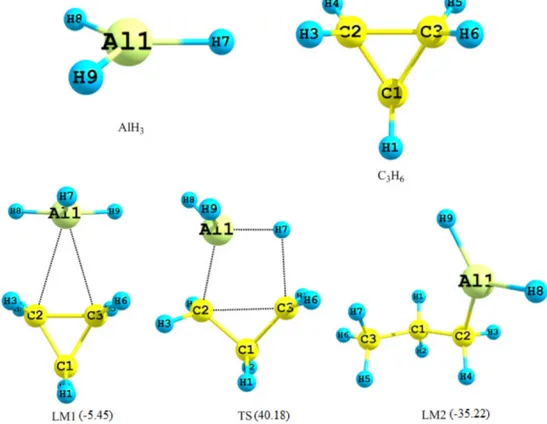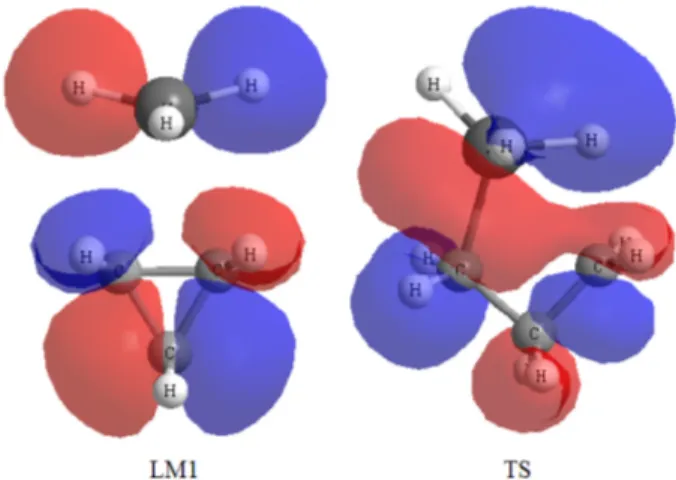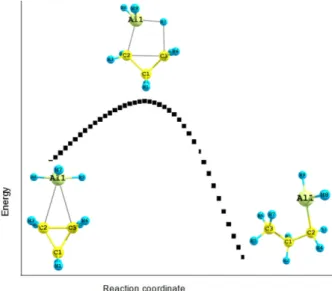Printed in the Republic of Korea
http://dx.doi.org/10.5012/jkcs.2013.57.2.216
Theoretical Study of the Hydroalumination Reaction of Cyclopropane with Alane
Satya Prakash Singh* and Pompozhi Protasis Thankachan
Department of Chemistry, Indian Institute of Technology Roorkee, Roorkee 247667, India
*E-mail: satyapiit@gmail.com
(Received November 5, 2012; Accepted February 19, 2013)
ABSTRACT. The hydroalumination of cyclopropane has been investigated using the B3LYP density functional method employing several split-valence basis sets. It is shown that the reaction proceeds via an intermediate weakly bound complex and a four-centered transition state. Calculations at higher levels of theory were also performed at the geometries optimized at the B3LYP level, but only slight changes in the barriers were observed. Structural parameters for the transition state are also reported.
Key words: Hydroalumination, Cyclopropane, Intermediate complex, Transition state, Propylalane
INTRODUCTION
Aluminium and boron belong to group III in the peri- odic table but there is large difference in their chemistry.1−3 Only a few hydrides of aluminium are known along with monomer AlH3 and dimer Al2H6 while boron has a richer chemistry4,5 in the inorganic as well as organic chemistry.
Hydrides of aluminium are good reducing agents and used as reducing agent for functional groups, hydroalumina- tion of alkenes, alkynes, allylic rearrangement in organic chemistry.6
The addition of the Al−H bonds to the double or triple bonds of unsaturated organic compounds (hydroalumina- tion) finds widespread application as a very powerful method for the reduction of specific substrates in organic synthe- sis.7−15
The addition of an alkene or alkyne into the Al−H bond of an alkyl aluminium hydride is a key first step in the route to the formation of a new carbon−hydrogen bond via hydroalumination. For further understanding Bunden and Francl16 used ab initio molecular orbital methods to probe the reaction path for the addition of carbon−carbon mul- tiple bonds into Al−H bonds.
Several theoretical studies of the hydroalumination of ethylene and acetylene have appeared. It has been sug- gested that the reaction involve the formation of a sym- metric π-complex intermediate leading to the formation of addition product via a four-centered transition state. Explor- atory work by Egger supports these results.17 The alternative π-complex transition state proposed by Eisch;18 however, is inconsistent with both the theoretical studies and the
experimental work of Egger and others. In 1981, Grophen and Haaland characterized the transition structure for the addition of acetylene into the Al−H bond of alane.19 One year later, they have reported the transition structure for the parallel addition reaction of AlH3 with ethylene.20 Sakai described a push-pull two-stage mechanism for the sim- ilar reaction of AlH3 with ethylene.21 Sakai’s charge anal- ysis on hydroalumination of ethylene suggested initial Al- C bond formation occurred which is found rapid than the breaking Al−H and the making of C−H bonds. Higashi et al. Investigated the reverse reaction of AlH3+C2H4 in the context of its application to chemical vapor deposition.22 They have reported a four-centered alane-ethylene tran- sition structure using a more sophisticated theoretical model, although no substantial differences were found.
Houk et al.23,24 have examined the reaction path for the analogous hydroboration reaction with a variety of substrates.
The intermediates, and transition structures found in these studies are consistent with those for the hydroalumination pathway described earlier. Qualitatively, the energetics of these pathways compare well with those from the simple hydroalumination reaction studied earlier. Schleyer and Hommes26 have examined the structure of the transition state for the reaction of dimethylborane and ethylene using correlated methods and suggest that the TS has a three- centered rather than four-centered structure. Chey et al.27 have previously characterized the π-complex intermedi- ates for hydroalumination of alkenes. In 1999 Bunden et al.28 have studied the transition state for the carboalumi- nation of alkene and alkynes at ab initio level of theory.
They have shown that these reactions are essentially nucleo-
philic attacks by alkyl anions on the substrate activated by lewis acid substituents.
Togni and Grutzmacher29 in 2001 have proposed metal- catalysed hydroalumination reactions of alkenes and alkynes and suggested that the catalytic hydroalumination of alk- enes and alkynes is the potential tool for the functional- ization of carbon−carbon multiple bonds. Among the different catalytic systems titanium (Ti), Zirconium (Zr) and Nickel (Ni) catalysts have found the widest application. Pankratyev et al.30 has recently carried out a DFT study on the mech- anism of olefin hydroalumination by XAlBu2i in the pres- ence of Cp2ZrCl2 catalyst for the mechanism of intermediate formation.
In the present paper, we have reported the results of our investigation of the reaction between cyclopropane and alane at DFT level of theory. Unlike hydroboration of cyclopropane31 we found a four-centered transition state leading to the formation of n-propyl alane. A four-cen- tered transition state occurs on the approach of AlH3 moi- ety along the plane of cyclopropane ring and preceded by an intermediate complex.
Computational Methods
All calculations have been performed on a PC running
WINDOWS using the Gaussian 9832 suite of programs.
The B3LYP hybrid density functional was used for calcula- tion at DFT33 level using several split-valence basis sets.
The geometries of the reactants (AlH3 and C3H6), inter- mediate complex (LM1), transition state (TS) and the product (LM2) were optimized at this level of theory using 6-31G**, 6-31++G**,34−40 cc-pVDZ and aug-cc-pVTZ41−45 basis sets. The nature of each stationary point was confirmed in each case by frequency calculations; all the minima were verified to have all positive frequencies and the transition state to have only one imaginary frequency. MP246−50 cal- culations were also performed using the chosen basis sets for comparison purposes. Single point (SP) calculations were as well performed at the geometries optimized at the B3LYP/6-31G** level at the CCSD, CCSD(T), QCISD, QCISD(T)51−55 and MP4SDQ levels to see if any significant change in the energetics is observed.
RESULTS AND DISCUSSION
The geometries of the reactants (AlH3 and C3H6), the intermediate complex (LM1), the transition state (TS) and product (LM2) optimized at the B3LYP/6-31G** level are shown in Fig. 1. The optimized geometrical parameters
Fig. 1. B3LYP/6-31G** optimized geometries of the reactants (AlH3 and C3H6), complex (LM1), transition state (TS) and product (LM2). Energies are in kcal mol−1.
for these species are collected in Table 1. Along the reac- tion path of cyclopropane and alane, three stationary points are located. The first is an intermediate complex (LM1) between the reactants, which is found to be more stable than the reactants by 5.45 kcal mol−1, the second a transition state (TS) and third the product (LM2).
The alane cyclopropane complex is found to be a stable intermediate along hydroalumination pathway. The carbon− carbon (C2−C3) bond length is not significantly affected by binding to the aluminium in the intermediate complex with cyclopropane while the considerable increase in the C2−C3 bond in the transition state has been noted.
The bond-making and bond breaking parameters for the cyclopropane and alane reaction, reactants (C3H6 and AlH3), intermediate complex, transition structure and addition product are collected in Table 1. The results are parallel to earlier works on hydroalumination of other substructures.20 We find the transition structure being best characterized four-centered structure unlike in the case of hydrobora- tion of cyclopropane in which a three-centered transition
structure has been reported recently. The formation of the product propylalane (LM2) from the transition state (TS) involves H7, originally attached to the boron (B1) shift- ing closer to the C3 and the boron (B1) moving towards C2, the bond between C2 and C3 lengthening and ulti- mately breaking. The cleavage of C2−C3 bond can be seen by the examining the molecular orbital picture for the tran- sition structure of cyclopropane with alane. The molecular orbital plot in Fig. 2 shows the cleavage of the C2−C3 π- system in the cyclopropane ring.
The energies relative to the sum of the reactants, C3H6 and AlH3 (in kcal mol−1) obtained are summarized in Table 2. The aluminium trihydride and cyclopropane reac- tants are collapsed without the energy barrier to form weakly bound intermediate complex. This intermediate then has surmount a barrier of the order of 45.63 kcal mol−1 via a four-centered transition structure before forming the more stable (about 35.22 kcal mol−1) cyclopropane-alane addition product at B3LYP/6-31G**level of theory and basis set.
Even though the geometry of the intermediate does not change substantially as larger basis sets are used for opti- mization, the energy of complexation changes consider- ably a variation of nearly 2 kcal mol−1 variation for the different theoretical models used. The larger basis set aug- cc-pVTZ gave calculated binding energy of the complex of −4.03 kcal mol−1 with −5.45 kcal mol−1 with the 6-31G**
basis with a B3LYP functional.
The computed barriers (ETS) are much higher than the available experimental activation energy of about 4.9 kcal mol−1 reported in the case of diethyl aluminium hydride to ethylene.56 Theoretically, Grophen and Haaland19,20 reported Table 1. Optimized structural parameters (bond lengths in Å and
angles in degree) for the reactants, complex (LM1, transition state (TS) and product (LM2)
AlH3 C3H6 LM1 TS LM2
R(Al1-H7) 1.586 1.589 1.653 3.084
R(Al1-H8) 1.586 1.589 1.595 1.592
R(Al1-H9) 1.587 1.590 1.597 1.592
R(C1-C3) 1.509 1.501 1.467 1.531
R(C2-C3) 1.508 1.548 2.165 2.562
R(C1-C2) 1.508 1.501 1.546 1.541
R(C1-H1) 1.085 1.084 1.091 1.097
R(C1-H2) 1.085 1.085 1.092 1.099
R(C2-H3) 1.085 1.085 1.091 1.103
R(C2-H4) 1.085 1.084 1.089 1.099
R(C3-H5) 1.085 1.084 1.082 1.096
R(C3-H6) 1.085 1.086 1.083 1.094
R(Al1-C2) 2.735 2.112 1.974
R(Al1-C3) 2.733 2.606 3.492
R(C3-H7) 2.996 1.995 1.098
∠C1C2C3 60.0 58.9 42.6 33.3
∠C2C3C1 59.9 58.9 45.5 33.6
∠C3C1C2 60.0 62.0 91.7 112.9
∠ H7Al1H9 119.9 119.1 107.0 76.3
∠ H8Al1H9 119.9 119.1 123.4 118.5
∠ H8Al1H7 120.0 118.6 107.5 135.7
∠ C2C3Al1 73.6 51.5 33.8
∠ C3C2Al1 73.5 75.0 99.8
∠ C2Al1C3 32.8 53.3 46.2
∠ C3Al1C2 32.8 53.3 46.2
Fig. 2. HOMOs of complex (LM1) and transition state (TS) for the hydroalumination of cyclopropane at B3LYP/6-31G** level of calculation.
the barriers of 14.0 and 11.9 kcal mol−1 for the hydroalu- mination of acetylene and ethylene respectively. The com- puted values for cyclopropane are higher than these too.
Calculated relative energies in kcal mol−1 of the sta- tionary structure along the reaction pathway at DFT and MP2 levels using different basis sets are given in Table 2.
Single point energies computed at higher levels of theory for structures optimized at the B3LYP/6-31G** level of theory and basis set are listed in Table 2. While there are substantial variations in the barriers, the energies of the product are not very sensitive to the level of calculations.
IRC calculations have been performed and confirm that the transition structure (TS) does fall on the path between the complex (LM1) and the product (LM2). The IRC plot is displayed in Fig. 3 shows the transition structure (TS) moving downhill towards the complex (LM1) on one side and the product (LM2) the other. Frequency calculations have been performed on all stationary structures. All pos-
itive frequencies are found for the stable species (AlH3, C3H6, LM1 and LM2) and one imaginary frequency (798 cm−1) is observed in the case of TS.
The qualitative trends found parallel those found in the B3LYP/6-31G** calculations, attesting to the essential validity of this DFT scheme in such studies. It may also be noted that the MP2 energies of the complex (LM1) are somewhat lower than in the other cases and that the values show less variability with the basis set chosen. These results suggest an energy barrier less than 50.46 kcal mol−1 of energy barrier calculated at the MP2/6-31G** level of theory and basis set, making the reaction viable; however, no experimental results are available for comparison.
CONCLUDING REMARKS
In summary, we have studied the stationary structures involved in the hydroalumination of cyclopropane with alane.
Our study posits a four-centered transition state for this reaction in contrast to the recent studies on the hydrob- oration of cyclopropane, in which three-centered transi- tion state has been reported. It is also hoped that studies on reactions involving cyclopropane and its derivatives with other hydroalumination reagents will clarify the situation.
Acknowledgments. One of the authors (S.P.S.) is grate- ful to the Ministry of Human Resources and Development (MHRD), Government of India for the award of a fellow- ship. And the publication cost of this paper was supported by the Korean Chemical Society.
REFERENCES
1. Aldridge, S.; Downs, A. J. Chem. Rev. 2001, 101(11), 3305−3366.
Table 2. Relative energies (in kcal/mol) at different levels and basis sets
Method Reactants ∆ELM 1 ∆ETS ∆ELM 2
B3LYP/6-31G** 0.00 −5.45 40.18 −35.22
B3LYP/cc-pVDZ 0.00 −4.34 41.63 −33.80
B3LYP/6-311++G** 0.00 −3.72 41.71 −34.11
B3LYP/AUG-cc-pVTZ 0.00 −4.03 41.54 −33.72
MP2/6-31G** 0.00 −7.33 50.46 −36.09
MP2/cc-pVDZ 0.00 −7.03 49.79 −35.66
aQCISD/6-31G** 0.00 −6.00 48.57 −35.97
aQCISD(T)/6-31G** 0.00 −6.78 46.00 −36.20
aMP4SDQ/6-31G** 0.00 −5.70 49.32 −35.22
aCCSD/6-31G** 0.00 −5.98 49.46 −35.91
aCCSD(T)/6-31G** 0.00 −6.77 59.02 −36.18
aSingle point calculations on the B3LYP/6-31G** structures.
Fig. 3. IRC plot for the transition state at the B3LYP/6-31G** level.
2. Rao, B. K.; et al. Phys. Rev. Lett. 2001, 86(4), 692.
3. Gámez, J. A.; et al., Chemistry – A European Journal 2008, 14(7), 2201−2208.
4. Greenwood, N. N. Chem. Soc. Rev. 1992, 21(1), 49−57.
5. Lipscomb, W. N. Science 1977, 196(4294), 1047−1055.
6. Carey, A.; Sundberg, R. J. Advanced Organic Chemistry:
Structure and Mechanisms; Springer: New York, 2000.
7. Zweifel, G.; Miller, J. A. Org. React. 1984, 32, 375.
8. Winterfeldt, E. Synthesis 1975, 1975(10), 617−630.
9. Marek, I.; Normant, J. F. Chem. Rev. 1996, 96(8), 3241−
3268.
10. Eisch, J. J. In Comprehensive Organic Synthesis; Brew- ster, J. H., Ed.; Pergamon Press: Oxford, 1991; Vol. 8, p 733.
11. Zweifel, G., In Aspects of Mechanism and Organometallic Chemistry; Brewster, J. H., Ed.; Plenum Press: New York, 1978.
12. Zweifel, G. In Comprehensive Organic Chemistry; Bar- ton, D. H. R.; Ollis, W. D., Eds.; Pergamon Press: Oxford, 1979; p 1013.
13. Negishi, E. Organometallics in Organic Synthesis; Wiley:
New York, 1980.
14. Saito, S. In Main Group Metals in Organic Synthesis;
Yamamoto, H.; Oshima, K., Eds.; Wiley-VCH: Weinheim, 2004; p 189.
15. Miller, J. A. In Chemistry of Aluminum, Gallium, Indium and Thallium; Downs, A. J., Ed.; Blackie Academic: Lon- don, 1993; p 372.
16. Bundens, J. W.; Francl, M. M. Organomet. 1993, 12(5), 1608−1615.
17. Egger, K. W. J. Am. Chem. Soc. 1969, 91(11), 2867−
2871.
18. Eisch, J. J. In Comprehensive Organometallic Chemistry;
Wilkinson, G.; Stone, F. G. A.; Abel, E. W., Eds.; Perga- mon Press: Oxford, U.K., 1982; Chapter 6.
19. Gropen, O.; Haaland, A. Acta. Chem. Scand. Ser. A 1981, 35, 305.
20. Gropen, O.; Haaland, A. Acta. Chem. Scand. Ser. A 1982, 36, 435.
21. Sakai, S. J. Phys. Chem. 1991, 95(1), 175−178.
22. Higashi, G. S.; Raghavachari, K.; Steigerwald, M. L. J.
Vac. Sci. Tech. B: Microelectronics and Nanometer Struc- tures 1990, 8(1), 103−105.
23. Dahlmann, M.; Lautens, M. In Metal-Catalysed Hydroalu- mination Reactions; Togni, A., Grüzmacher, H., Eds.; Wiley- VCH Verlag GmbH: 2001.
24. Pankratyev, E. Y.; et al. Organomet. 2009, 28(4), 968−977.
25. Houk, K. N.; et al. Tetrahedron 1984, 40(12), 2257−2274.
26. Wang, X.; et al. J. Org. Chem. 1990, 55(9), 2601−2609.
27. Nagase, S.; Ray, N. K.; Morokuma, K. J. Am. Chem. Soc.
1980, 102(13), 4536−4537.
28. Van Eikema Hommes, N. J. R.; Schleyer, P. V. R. J. Org.
Chem. 1991, 56(12), 4074−4076.
29. Chey, J.; et al. Organomet. 1990, 9(9), 2430−2436.
30. Bundens, J. W.; Yudenfreund, J.; Francl, M. M. Orga- nomet. 1999, 18(19), 3913−3920.
31. Singh, S. P.; Thankachan, P. P. J. Mol. Model. 2011, 18(2), 751−754.
32. Frisch, M. J.; et al. GAUSSIAN98, revision A.7; Gaussian, Inc.: Pittsburgh, PA, 1998.
33. Becke, A. D. J. Chem. Phys. 1993, 98, 5648−5652.
34. Gordon, M. S. J. Am. Chem. Soc. 1980, 102(25), 7419−
7422.
35. Ditchfield, R.; Hehre, W. J.; Pople, J. A. J. Chem. Phys.
1971, 54(2), 724−728.
36. Hehre, W. J.; Ditchfield, R.; Pople, J. A. J. Chem. Phys.
1972, 56(5), 2257−2261.
37. Hariharan, P. C.; Pople, J. A. Mol. Phys.: An Interna- tional Journal at the Interface between Chemistry and Physics 1974, 27(1), 209−214.
38. Hariharan, P. C.; Pople, J. A. Theoretical Chemistry Accounts:
Theory, Computation, and Modeling. Theoretica Chimica Acta 1973, 28(3), 213−222.
39. Clark, T.; et al. J. Comp. Chem. 1983, 4(3), 294−301.
40. Frisch, M. J.; Pople, J. A.; Binkley, J. S. J. Chem. Phys.
1984, 80(7), 3265−3269.
41. Woon, D. E.; Dunning, J. T. H. J. Chem. Phys. 1993, 98(2), 1358−1371.
42. Kendall, R. A.; Dunning, J. T. H.; Harrison, R. J. J. Chem.
Phys. 1992, 96(9), 6796−6806.
43. Dunning, J. T. H. J. Chem. Phys. 1989, 90(2), 1007−1023.
44. Peterson, K. A.; Woon, D. E.; Dunning, J. T. H. J. Chem.
Phys. 1994, 100(10), 7410−7415.
45. Wilson, A. K.; van Mourik, T.; Dunning, T. H. J. Mol.
Struct.: THEOCHEM, 1996, 388, 339−349.
46. Head-Gordon, M.; Pople, J. A.; Frisch, M. J. Chem. Phys.
Lett. 1988, 153(6), 503−506.
47. Frisch, M. J.; Head-Gordon, M.; Pople, J. A. Chem. Phys.
Lett. 1990, 166(3), 275−280.
48. Frisch, M. J.; Head-Gordon, M.; Pople, J. A. Chem. Phys.
Lett. 1990, 166(3), 281−289.
49. Head-Gordon, M.; Head-Gordon, T. Chem. Phys. Lett.
1994, 220(1−2), 122−128.
50. Sæbø, S.; Almlöf, J. Chem. Phys. Lett. 1989, 154(1), 83−
89.
51. Cizek, J. Adv. Chem. Phys. 1969, 14, 35.
52. Purvis, G. D.; Bartlett, R. J. J. Chem. Phys. 1982, 76(4), 1910−1918.
53. Scuseria, G. E.; Janssen, C. L.; Schaefer, H. F. J. Chem.
Phys. 1988, 89(12), 7382−7387.
54. Scuseria, G. E.; Schaefer, H. F. J. Chem. Phys. 1989, 90(7), 3629−3636.
55. Pople, J. A.; Gordon, M. J. Am. Chem. Soc. 1967, 89(17), 4253−4261.
56. Cocks, A. T.; Egger, K. W. J. Chem. Soc., Faraday Transac- tions 1: Physical Chemistry in Condensed Phases 1972, 68, 423−428.


